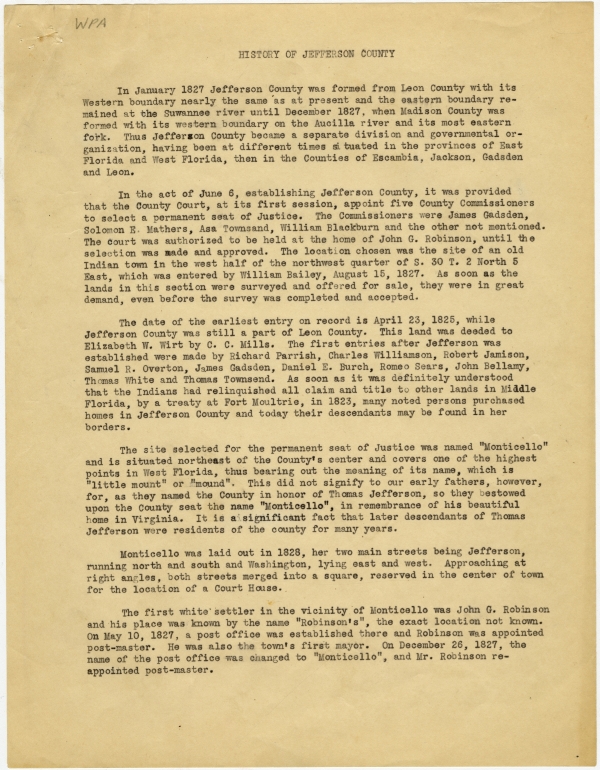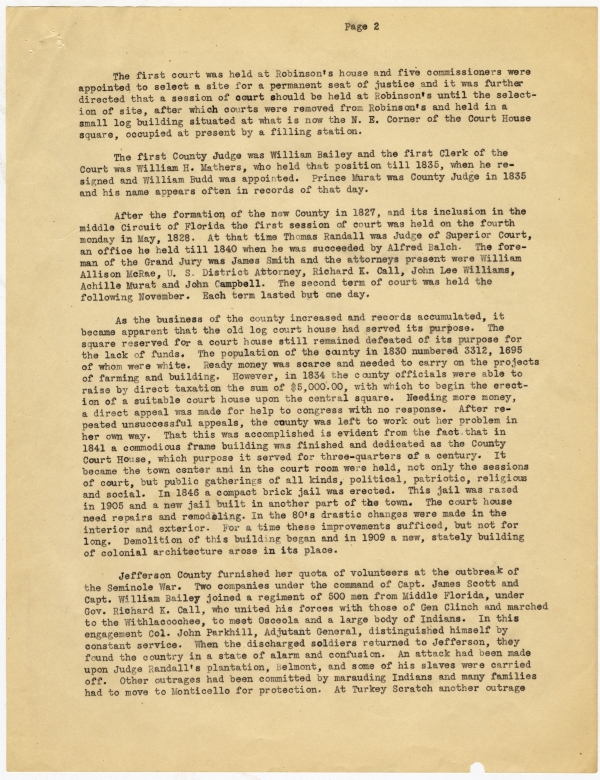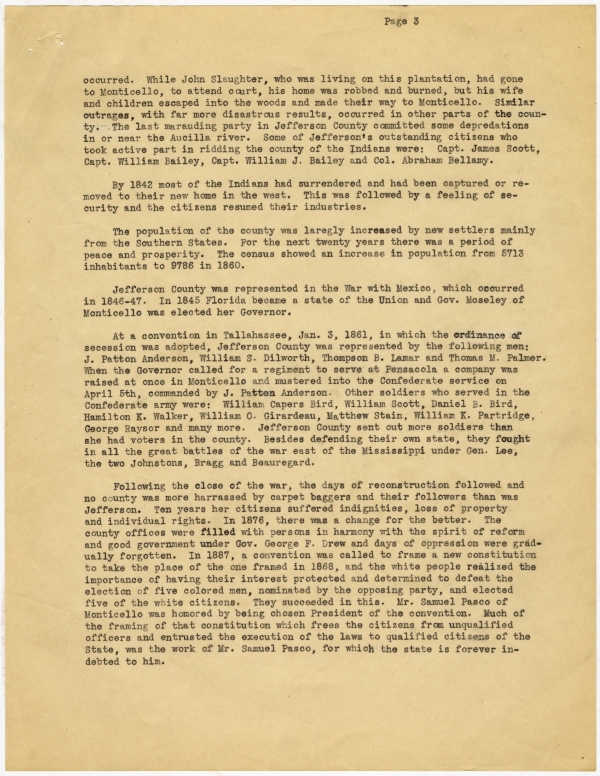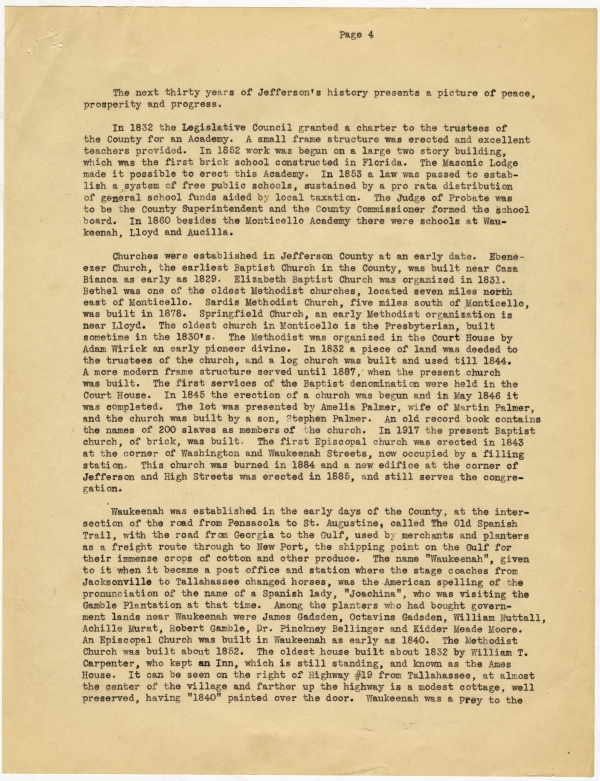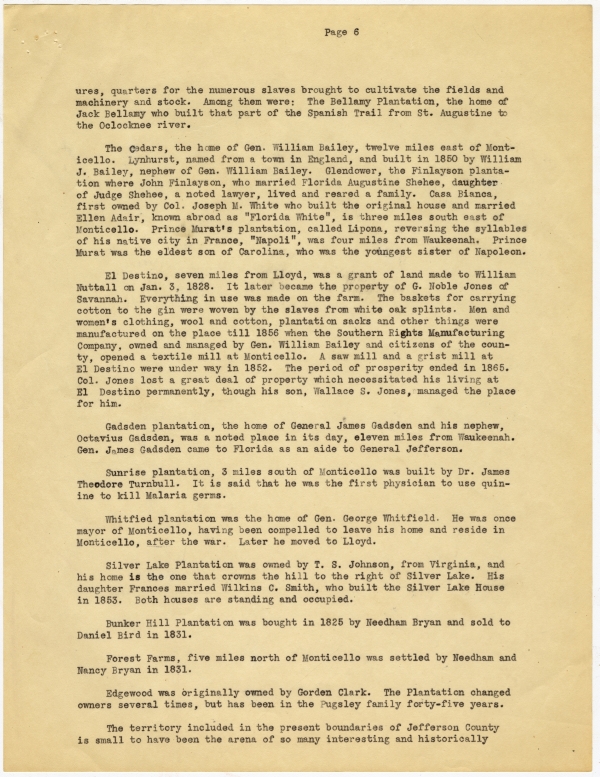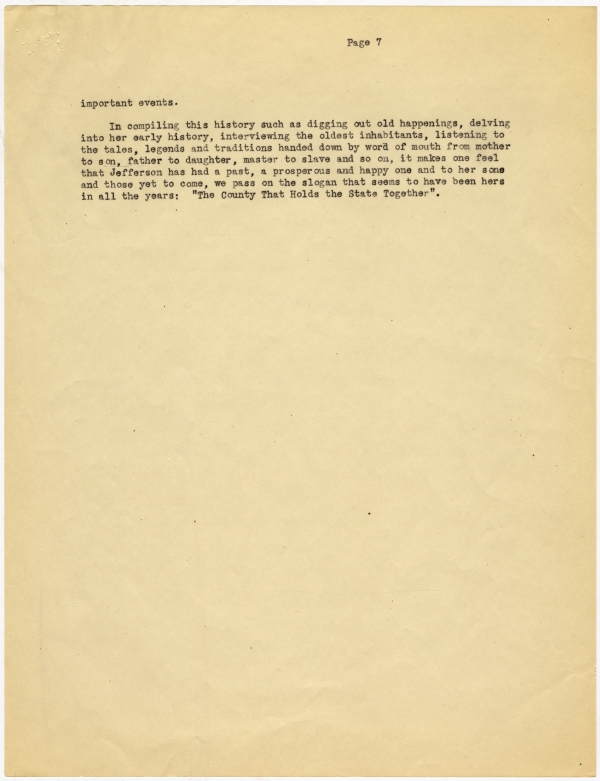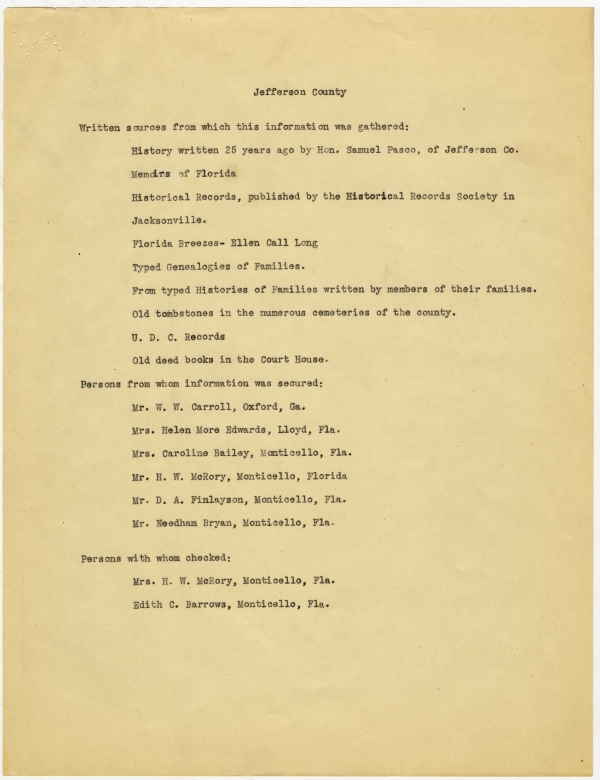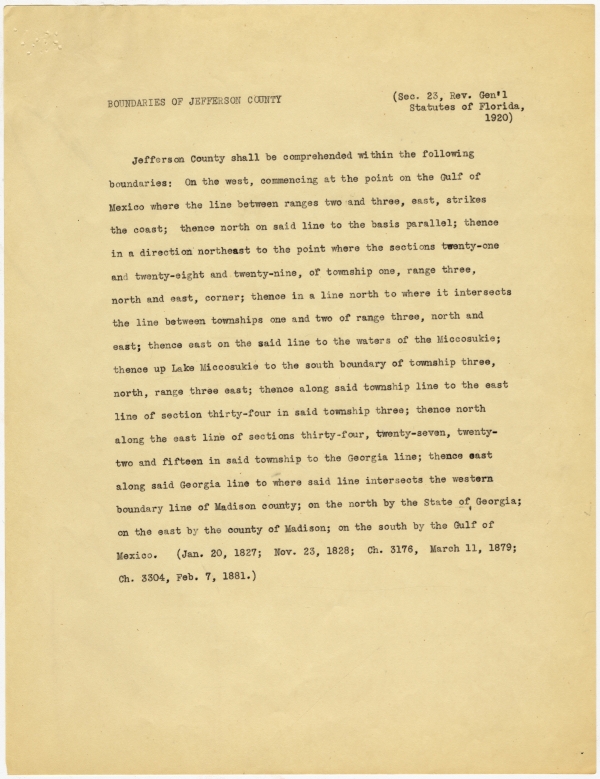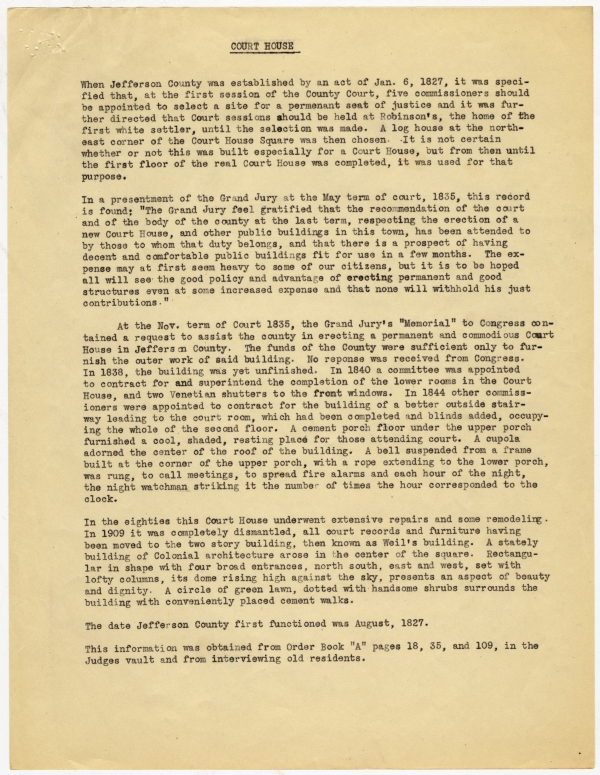Transcript
WPA
HISTORY OF JEFFERSON COUNTY
In January 1827 Jefferson County was formed from Leon County with its Western boundary nearly the same as at present and the eastern boundary remained at the Suwannee river until December 1827, when Madison County was formed with its western boundary on the Aucilla river and its most eastern fork. Thus Jefferson County became a separate division and governmental organization, having been at different times situated in the provinces of East Florida and West Florida, then in the Counties of Escambia, Jackson, Gadsden and Leon.
In the act of June 6, establishing Jefferson County, it was provided that the County Court, at its first session, appoint five County Commissioners to select a permanent seat of Justice. The Commissioners were James Gadsden, Solomon E. Mathers, Asa Townsand, William Blackburn and the other not mentioned. The court was authorized to be held at the home of John G. Robinson, until the selection was made and approved. The location chosen was the site of an old Indian town in the west half of the northwest quarter of S. 30 T. 2 North 5 East, which was entered by William Bailey, August 15, 1827. As soon as the lands in this section were surveyed and offered for sale, they were in great demand, even before the survey was completed and accepted.
The date of the earliest entry on record is April 23, 1825, while Jefferson County was still a part of Leon County. This land was deeded to Elizabeth W. Wirt by C. C. Mills. The first entries after Jefferson was established were made by Richard Parrish, Charles Williamson, Robert Jamison, Samuel R. Overton, James Gadsden, Daniel E. Burch, Romeo Sears, John Bellamy, Thomas White and Thomas Townsend. As soon as it was definitely understood that the Indians had relinquished all claim and title to other lands in Middle Florida, by a treaty at Fort Moultrie, in 1823, many noted persons purchased homes in Jefferson County and today their descendants may be found in her borders.
The site selected for the permanent seat of Justice was named "Monticello" and is situated northeast of the County's center and covers one of the highest points in West Florida, thus bearing out the meaning of its name, which is "little mount" or "mound". This did not signify to our early fathers, however, for, as they named the County in honor of Thomas Jefferson, so they bestowed upon the County seat the name "Monticello", in remembrance of his beautiful home in Virginia. It is a significant fact that later descendants of Thomas Jefferson were residents of the county for many years.
Monticello was laid out in 1828, her two main streets being Jefferson, running north and south and Washington, lying east and west. Approaching at right angles, both streets merged into a square, reserved in the center of town for the location of a Court House.
The first white settler in the vicinity of Monticello was John G. Robinson and his place was known by the name "Robinson's", the exact location not known. On May 10, 1827, a post office was established there and Robinson was appointed post-master. He was also the town's first mayor. On December 26, 1827, the name of the post office was changed to "Monticello", and Mr. Robinson reappointed post-master.
Page 2
The first court was held at Robinson's house and five commissioners were appointed to select a site for a permanent seat of justice and it was further directed that a session of court should be held at Robinson's until the selection of site, after which courts were removed from Robinson's and held in a small log building situated at what is now the N. E. Corner of the Court House square, occupied at present by a filling station.
The first County Judge was William Bailey and the first Clerk of the Court was William H. Mathers, who held that position till 1835, when he resigned and William Budd was appointed. Prince Murat was County Judge in 1835 and his name appears often in records of that day.
After the formation of the new County in 1827, and its inclusion in the middle Circuit of Florida the first session of court was held on the fourth monday in May, 1828. At that time Thomas Randall was Judge of Superior Court, an office he held till 1840 when he was succeeded by Alfred Balch. The foreman of the Grand Jury was James Smith and the attorneys present were William Allison McRae, U. S. District Attorney, Richard K. Call, John Lee Williams, Achille Murat and John Campbell. The second term of court was held the following November. Each term lasted but one day.
As the business of the county increased and records accumulated, it became apparent that the old log court house had served its purpose. The square reserved for a court house still remained defeated of its purpose for the lack of funds. The population of the county in 1830 numbered 3312, 1695 of whom were white. Ready money was scarce and needed to carry on the projects of farming and building. However, in 1834 the county officials were able to raise by direct taxation the sum of $5,000.00, with which to begin the erection of a suitable court house upon the central square. Needing more money, a direct appeal was made for help to congress with no response. After repeated unsuccessful appeals, the county was left to work out her problem in her own way. That this was accomplished is evident from the fact that in 1841 a commodious frame building was finished and dedicated as the County Court House, which purpose it served for three-quarters of a century. It became the town center and in the court room were held, not only the sessions of court, but public gatherings of all kinds, political, patriotic, religious and social. In 1846 a compact brick jail was erected. This jail was razed in 1905 and a new jail built in another part of the town. The court house need [sic] repairs and remodeling. In the 80's drastic changes were made in the interior and exterior. For a time these improvements sufficed, but not for long. Demolition of this building began and in 1909 a new, stately building of colonial architecture arose in its place.
Jefferson County furnished her quota of volunteers at the outbreak of the Seminole War. Two companies under the command of Capt. James Scott and Capt. William Bailey joined a regiment of 500 men from Middle Florida, under Gov. Richard K. Call, who united his forces with those of Gen Clinch and marched to the Withlacoochee, to meet Osceola and a large body of Indians. In this engagement Col. John Parkhill, Adjutant General, distinguished himself by constant service. When the discharged soldiers returned to Jefferson, they found the country in a state of alarm and confusion. An attack had been made upon Judge Randall's plantation, Belmont, and some of his slaves were carried off. Other outrages had been committed by marauding Indians and many families had to move to Monticello for protection. At Turkey Scratch another outrage
Page 3
occurred. While John Slaughter, who was living on this plantation, had gone to Monticello, to attend court, his home was robbed and burned, but his wife and children escaped into the woods and made their way to Monticello. Similar outrages, with far more disastrous results, occurred in other parts of the county. The last marauding party in Jefferson County committed some depredations in or near the Aucilla river. Some of Jefferson's outstanding citizens who took active part in ridding the county of the Indians were: Capt. James Scott, Capt. William Bailey, Capt. William J. Bailey and Col. Abraham Bellamy.
By 1842 most of the Indians had surrendered and had been captured or removed to their new home in the west. This was followed by a feeling of security and the citizens resumed their industries.
The population of the county was [largely] increased by new settlers mainly from the Southern States. For the next twenty years there was a period of peace and prosperity. The census showed an increase in population from 5713 inhabitants to 9786 in 1860.
Jefferson County was represented in the War with Mexico, which occurred in 1846-47. In 1845 Florida became a state of the Union and Gov. Moseley of Monticello was elected her Governor.
At a convention in Tallahassee, Jan. 3, 1861, in which the ordinance of secession was adopted, Jefferson County was represented by the following men: J. Patton Anderson, William S. Dilworth, Thompson B. Lamar and Thomas M. Palmer. When the Governor called for a regiment to serve at Pensacola a company was raised at once in Monticello and mustered into the Confederate service on April 5th, commanded by J. Patten Anderson. Other soldiers who served in the Confederate army were: William Capers Bird, William Scott, Daniel B. Bird, Hamilton K. Walker, William O. Girardeau, Matthew Stain, William K. Partridge, George Raysor and many more. Jefferson County sent out more soldiers than she had voters in the county. Besides defending their own state, they fought in all the great battles of the war east of the Mississippi under Gen. Lee, the two Johnstons, Bragg and Beauregard.
Following the close of the war, the days of reconstruction followed and no county was more harrassed by carpet baggers and their followers than was Jefferson. Ten years her citizens suffered indignities, loss of property and individual rights. In 1876, there was a change for the better. The county offices were filled with persons in harmony with the spirit of reform and good government under Gov. George F. Drew and days of oppression were gradually forgotten. In 1887, a convention was called to frame a new constitution to take the place of the one framed in 1868, and the white people realized the importance of having their interest protected and determined to defeat the election of five colored men, nominated by the opposing party, and elected five of the white citizens. They succeeded in this. Mr. Samuel Pasco of Monticello was ho[n]ored by being chosen President of the convention. Much of the framing of that constitution which frees the citizens from unqualified officers and entrusted the execution of the laws to qualified citizens of the State, was the work of Mr. Samuel Pasco, for which the state is forever indebted to him.
Page 4
The next thirty years of Jefferson's history presents a picture of peace, prosperity and progress.
In 1832 the Legislative Council granted a charter to the trustees of the County for an Academy. A small frame structure was erected and excellent teachers provided. In 1852 work was begun on a large two story building, which was the first brick school constructed in Florida. The Masonic Lodge made it possible to erect this Academy. In 1853 a law was passed to establish a system of free public schools, sustained by a pro rata distribution of general school funds aided by local taxation. The Judge of Probate was to be the County Superintendent and the County Commissioner formed the school board. In 1860 besides the Monticello Academy there were schools at Waukeenah, Lloyd and Aucilla.
Churches were established in Jefferson County at an early date. Ebeneezer Church, the earliest Baptist Church in the County, was built near Casa Bianca as early as 1829. Elizabeth Baptist Church was organized in 1831. Bethel was one of the oldest Methodist churches, located seven miles north east of Monticello. Sardis Methodist Church, five miles south of Monticello, was built in 1878. Springfield Church, an early Methodist organizatin is near Lloyd. The oldest church in Monticello is the Presbyterian, built sometime in the 1830's. The Methodist was organized in the Court House by Adam Wirick an early pioneer divine. In 1832 a piece of land was deeded to the trustees of the church, and a log church was built and used till 1844. A more modern frame structure served until 1887, when the present church was built. The first services of the Baptist denomination were held in the Court House. In 1845 the erection of a church was begun and in May 1846 it was completed. The lot was presented by Amelia Palmer, wife of Martin Palmer, and the church was built by a son, Stephen Palmer. An old record book contains the names of 200 slaves as members of the church. In 1917 the present Baptist church, of brick, was built. The first Episcopal church was erected in 1843 at the corner of Washington and Waukeenah Streets, now occupied by a filling station. This church was burned in 1884 and a new edifice at the corner of Jefferson and High Streets was erected in 1885, and still serves the congregation.
Waukeenah was established in the early days of the County, at the intersection of the road from Pensacola to St. Augustine, called The Old Spanish Trail, with the road from Georgia to the Gulf, used by merchants and planters as a freight route through to New Port, the shipping point on the Gulf for their immense crops of cotton and other produce. The name "Waukeenah", given to it when it became a post office and station where the stage coaches from Jacksonville to Tallahassee changed horses, was the American spelling of the pronunciation of the name of a Spanish lady, "Joachina", who was visiting the Gamble Plantation at that time. Among the planters who had bought government lands near Waukeenah were James Gadsden, Octavins Gadsden, William Nuttall, Achille Murat, Robert Gamble, Dr. Pinckney Bellinger and Kidder Meade Moore. An Episcopal Church was built in Waukeenah as early as 1840. The Methodist Church was built about 1852. The oldest house built about 1832 by William T. Carpenter, who kept an Inn, which is still standing, and known as the Ames House. It can be seen on the right of Highway #19 from Tallahassee, at almost the center of the village and farther up the highway is a modest cottage, well preserved, having "1840" painted over the door. Waukeenah was a prey to the
Page 5
Indians and the inhabitants fled to Monticello for protection which retarded her progress. Thomas J. Moore was a native of the village and after the Civil War he became interested in the culture of the pecans. In 1874 he visited Texas and brought home two of the trees and some of the nuts which he planted. After experimenting a year or two a fine commercial nut was produced, and named the Moore Nut. Other prominent settlers were: Charles B. Ames, James Roach, Joseph Richard Saunders, Pinckney Grantham, Dr. Thomas Edwards, Dr. James Palmer, Lafayette Wooten. An Academy was built at an early date and in 1859 Hon. Samuel Pasco was chosen Principal. He led a company of young men through the Civil War, after which he settled in Monticello, serving the county and his adopted state in several important capacities, among which was U. S. Senator and later a member of the Isthmian Canal Commission.
The town of Lloyd was at first Bailey's Mill and Lloyd Creek was Bailey's Mill Creek. William Bailey bought up land around this spot, operated a grist and saw mill on this water course and a postoffice was established. When the S. A. L. Railroad was completed in 1858 this station was called No. 2. Later, when it became a thriving town, the name Lloyd was given to it, from W. F. Lloyd, a pioneer settler from New York. Among other settlers were Henry and Walter Bond with their mother, Jane Bond, a sister of W. F. Lloyd, George Dennis, Rondeau Lafitte, Gen. George Whitfield and others. For many years a famed dinner house for passengers on the S.A.L. trains going east and west was operated by Ge. Whitfield's widow. Two churches, an Episcopal and a Methodist, and an occasional Baptist service supplied the spiritual needs of the community.
Aucilla, a small town eleven miles from Monticello, was named from the river near which it lies. It was first called Williamsburg, then when the S.A.L. Railroad came through in 1858 the station was called No. 4. The first merchants were Thomas and Horton. Dr. Emory owned and operated the first drug store. A Methodist and a Baptist church were built in the eastern part of the town, near the present cemetery. The Aucilla Academy was given a charter by the Legislative Council in 1840, but insufficient funds prevented the erection of a building until years later.
Lamount had her beginning about 1863. Previous to that the postoffice [sic] was located at Beasley's store, owned and operated by Sam Beasley, one of the first settlers, who lived on Barber's Hill, on the Spanish Trail. The stage coach from St. Augustine stopped each day to change horses for Pensacola. In 1865 the post office was moved to McCain's store, the first business place in Lamount. For some time the place was called "Lick Skillet", and to offset this misnomer Sam P. Turnbull, owner of Turkey Scratch, suggested the dignified name of "Lamont", in honor of the Secretary of Grover Cleveland, Cornelius Lamont, who had recently visited Florida. The first church was a Missionary Baptist, later a Primitive Baptist was organized and later a Methodist Church.
After Florida was made a territory in 1819, U. S. engineers were commissioned to survey the lands and lawyers conversant with land grants were busy re-adjusting Spanish and English claims. Then followed an influx of planters from North Carolina, South Carolina, Kentucky, Virginia and Georgia. Large grants of land were made by the Government to plantations of large acreage, the establishment of homes, most of the houses being large colonial struct-
Page 6
ures, quarters for the numerous slaves brought to cultivate the fields and machinery and stock. Among them were: The Bellamy Plantation, the home of Jack Bellamy who built that part of the Spanish Trail from St. Augustine to the [Ochlockonee] river.
The Cedars, the home of Gen. William Bailey, twelve miles east of Monticello. Lynhurst, named from a town in England, and built in 1850 by William J. Bailey, nephew of Gen. William Bailey. Glendower, the Finlayson plantation where John Finlayson, who married Florida Augustine Shehee, daughter of Judge Shehee, a noted lawyer, lived and reared a family. Casa Bianca, first owned by Col. Joseph M. White who built the original house and married Ellen Adair, known abroad as "Florida White", is three miles south east of Monticello. Prince Murat's plantation, called Lipona, reversing the syllables of his native city in France, "Napoli", was four miles from Waukeenah. Prince Murat was the eldest son of Carolina, who was the youngest sister of Napoleon.
El Destino, seven miles from Lloyd, was a grant of land made to William Nuttall on Jan. 3, 1828. It later became the property of G. Noble Jones of Savannah. Everything in use was made on the farm. The baskets for carrying cotton to the gin were woven by the slaves from white oak splints. Men and women's clothing, wool and cotton, plantation sacks and other things were manufactured on the place till 1856 when the Southern Rights Manufacturing Company, owned and managed by Gen. William Bailey and citizens of the county, opened a textile mill at Monticello. A saw mill and a grist mill at El Destino were under way in 1852. The period of prosperity ended in 1865. Col. Jones lost a great deal of property which necessitated his living at El Destino permanently, though his son, Wallace S. Jones, managed the place for him.
Gadsden plantation, the home of General James Gadsden and his nephew, Octavius Gadsden, was a noted place in its day, eleven miles from Waukeenah. Gen. James Gadsden came to Florida as an aide to General Jefferson.
Sunrise plantation, 3 miles south of Monticello was built by Dr. James Theodore Turnbull. It is said that he was the first physician to use quinine to kill Malaria germs.
[Whitfield] plantation was the home of Gen. George Whitfield. He was once mayor of Monticello, having been compelled to leave his home and reside in Monticello, after the war. Later he moved to Lloyd.
Silver Lake Plantation was owned by T. S. Johnson, from Virginia, and his home is the one that crowns the hill to the right of Silver Lake. His daughter Frances married Wilkins C. Smith, who built the Silver Lake House in 1853. Both houses are standing and occupied.
Bunker Hill Plantation was bought in 1825 by Needham Bryan and sold to Daniel Bird in 1831.
Forest Farms, five miles north of Monticello was settled by Needham and Nancy Bryan in 1831.
Edgewood was originally owned by Gorden Clark. The Plantation changed owners several times, but has been in the Pugsley family forty-five years.
The territory included in the present boundaries of Jefferson County is small to have been the arena of so many interesting and historically
Page 7
important events.
In compiling this history such as digging out old happenings, delving into her early history, interviewing the oldest inhabitants, listening to the tales, legends and traditions handed down by word of mouth from mother to son, father to daughter, master to slave and so on, it makes one feel that Jefferson has had a past, a prosperous and happy one and to her sons and those yet to come, we pass on the slogan that seems to have been hers in all the years: "The County That Holds the State Together".
Jefferson County
Written sources from which this information was gathered:
History written 25 years ago by Hon. Samuel Pasco, of Jefferson Co.
Memoirs of Florida
Historical Records, published by the Historical Records Society in Jacksonville.
Florida Breezes- Ellen Call Long
Typed Genealogies of Families.
From typed Histories of Families written by members of their families.
Old tombstones in the numerous cemeteries of the county.
U. D. C. Records
Old deed books in the Court House.
Persons from whom information was secured:
Mr. W. W. Carroll, Oxford, Ga.
Mrs. Helen More Edwards, Lloyd, Fla.
Mrs. Caroline Bailey, Monticello, Fla.
Mr. H. W. McRory, Monticello, Florida
Mr. D. A. Finlayson, Monticello, Fla.
Mr. Needham Bryan, Monticello, Fla.
Persons with whom checked:
Mrs. H. W. McRory, Monticello, Fla.
Edith C. Barrows, Monticello, Fla.
BOUNDARIES OF JEFFERSON COUNTY
(Sec. 23, Rev. Gen'l Statutes of Florida, 1920)
Jefferson County shall be comprehended within the following boundaries: On the west, commencing at the point on the Gulf of Mexico where the line between ranges two and three, east, strikes the coast; thence north on said line to the basis parallel; thence in a direction northeast to the point where the sections twenty-one and twenty-eight and twenty-nine, of township one, range three, north and east, corner; thence in a line north to where it intersects the line between townships one and two of range three, north and east; thence east on the said line to the waters of the [Miccosukee]; thence up Lake [Miccosukee] to the south boundary of township three, north, range three east; thence along said township line to the east line of section thirty-four in said township three; thence north along the east line of sections thirty-four, twenty-seven, twenty-two and fifteen in said township to the Georgia line; thence east along said Georgia line to where said line intersects the western boundary line of Madison county; on the north by the State of Georgia; on the east by the county of Madison; on the south by the Gulf of Mexico. (Jan. 20, 1827; Nov. 23, 1828; Ch. 3176, March 11, 1879; Ch. 3304, Feb 7, 1881.)
COURT HOUSE
When Jefferson County was established by an act of Jan. 6, 1827, it was specified that, at the first session of the County Court, five commissioners should be appointed to select a site for a [permanent] seat of justice and it was further directed that Court sessions should be held at Robinson's, the home of the first white settler, until the selection was made. A log house at the northest corner of the Court House Square was then chosen. It is not certain whether or not this was built especially for a Court House, but from then until the first floor of the real Court House was completed, it was used for that purpose.
In a presentment of the Grand Jury at the May term of court, 1835, this record is found; "The Grand Jury feel gratified that the recommendation of the court and of the body of the county at the last term, respecting the erection of a new Court House, and other public buildings in this town, has been attended to by those to whom that duty belongs, and that there is a prospect of having decent and comfortable public buildings fit for use in a few months. The expense may at first seem heavy to some of our citizens, but it is to be hoped all will see the good policy and advantage of erecting permanent and good structures even at some increased expense and that none will withold his just contributions."
At the Nov. term of Court 1835, the Grand Jury's "Memorial" to Congress contained a request to assist the county in erecting a permanent and commodious Court House in Jefferson County. The funds of the County were sufficient only to furnish the outer work of said building. No response was received from Congress. In 1838, the building was yet unfinished. In 1840 a committee was appointed to contract for and superintend the completion of the lower rooms in the Court House, and two Venetian shutters to the front windows. In 1844 other commissioners were appointed to contract for the building of a better outside stairway leading to the court room, which had been completed and blinds added, occupying the whole of the second floor. A cement porch floor under the upper porch furnished a cool, shaded, resting place for those attending court. A cupola adorned the center of the roof of the building. A bell suspended from a frame built at the corner of the upper porch, with a rope extending to the lower porch, was rung, to call meetings, to spread fire alarms and each hour of the night, the night watchman striking it the number of times the hour corresponded to the clock.
In the eighties this Court House underwent extensive repairs and some remodeling. In 1909 it was completely dismantled, all court records and furniture having been moved to the two story building, then known as Weil's building. A stately building of Colonial architecture arose in the center of the square. Rectangular in shape with four broad entrances, north south, east and west, set with lofty columns, its dome rising high against the sky, presents an aspect of beauty and dignity. A circle of green lawn, dotted with handsome shrubs surrounds the building with conveniently placed cement walks.
The date Jefferson County first functioned was August, 1827.
This information was obtained from Order Book "A" pages 18, 35, and 109, in the Judges vault and from interviewing old residents.




 Listen: The Latin Program
Listen: The Latin Program